Product Close-ups
Product Close-up: Outside/In: Bachmann 2-4-2T
Jun 22, 2011

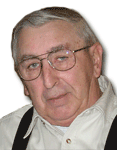
By Jon Miller |
Author
Bio
Bachmann has reintroduced their 2-4-2T locomotive first placed on sale the early part of 1994.This new offering from Bachmann is available in four variations. They are the Lyn, British version, and three Americanized versions. Come see inside and outside.
|
INTRODUCTION:Bachmann has reintroduced their 2-4-2T locomotive first placed on sale the early part of 1994. The model of 1994 was that of a locomotive produced by Baldwin Locomotive Works for the Southern Railway in England. That locomotive, the Lyn, was never catalogued and sold as a Spectrum model. The Lyn was green and black lettered SOUTHERN 762. Within a year or so another locomotive of the same design, this time Americanized, was sold for a short time. This new offering from Bachmann is available in four variations. They are the Lyn, British version, item number 91196. Three Americanized versions are offered as a Painted, Unlettered Black item number 91197; Painted, Unlettered - Black with Red Windows and White Pinstripes item number 91198; and Painted, Unlettered - Green & Black with White Pinstripes item number 91199. The new version 2-4-2T, sold under their Big Hauler series, is a greatly improved locomotive over the engine offered in 1994. The level of detail approaches that of a Spectrum model. It contains a totally new drive train and is DCC ready. THE NEW BACHMANN 2-4-2T LOCOMOTIVE 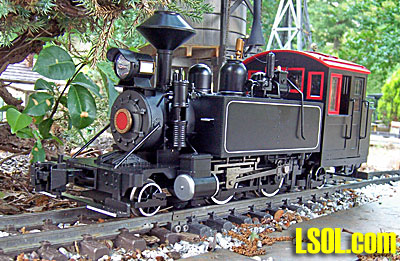
Here is an Outside/In look at the locomotive. TABULATED DATA: - Length: 15 3/4 inches (coupler face to coupler face). 13 3/4 inches (footboard to footboard)
.
- Width: 4 inches (measured at footboards the widest part of the engine)
.
- Height: 5 7/8 inches (from railhead to top of funnel stack)
.
- Weight: 4 lbs. 2 oz.
- Wheels Back to Back: Front truck 1.573 inches; Drivers 1.592 inches; Rear truck 1.590 inches.
- Electrical: Engine starts to move, either forward or reverse at .5 amps. Full slip at 1 amp.
PACKAGING: 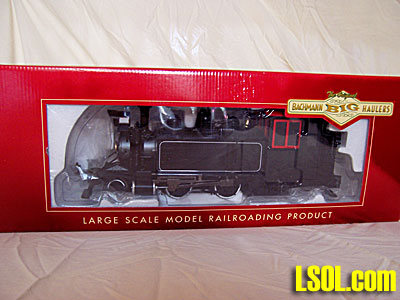
The locomotive comes packed in a styrofoam tray with a clear plastic cover to hold it in place. The engine arrived in excellent condition. There were no broken or loose pieces rattling around in its carrier.
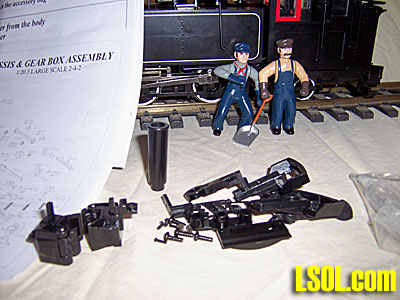 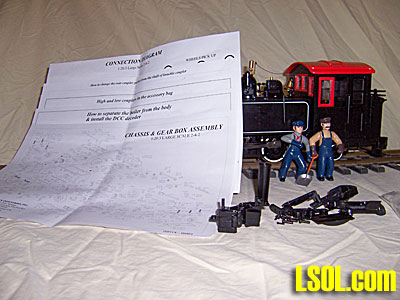
The first picture shows what items are received with the locomotive. There are two figures, straight stack, 1 pair of off-set knuckle couplers, pair of hook & loop couplers, 1 short shank coupler for rear of engine, and vial of smoke fluid. The second picture attempts to display the five pages of documentation supplied. Four of the pages are printed on both sides. The documentation contains a wealth of detail. Keep these handy for future reference. Also provided are Warranty sheets in a variety of languages along with an owner's registration card. Make sure you complete the owner's registration card and return to Bachmann. Should note that Bachmann does not provide an Owner's Manual, DVD, or lubrication instructions. You can live without the DVD but an Owner's Manual and lubrication instructions are both items one would expect with any locomotive.
OUTSIDE/IN REVIEW:First an Outside look at the engine starting at the front. 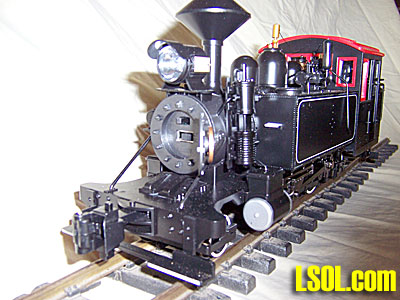
Behind the smoke box door are two switches. The top switch is smoke Off and On. The lower switch is three position polarity switch. Switch to left sets NMRA standard, center position is Off, switch to right sets Large Scale. 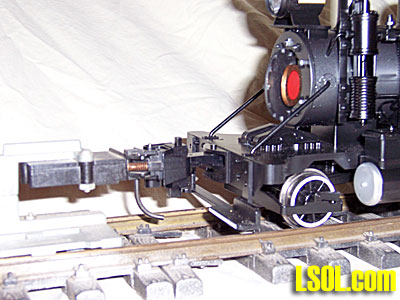
As delivered the engine is equipped with what Bachmann calls NMRA height couplers. There are off set couplers in the parts bag to change to a lower coupler height to match truck mounted couplers. The picture shows the coupler matches up with the Kadee coupler gauge. 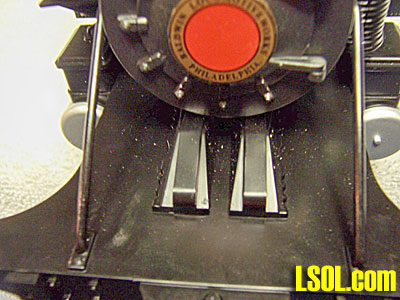
Mounted on the front pilot deck are two rerailers. Nice detail touch that dresses up the pilot deck.
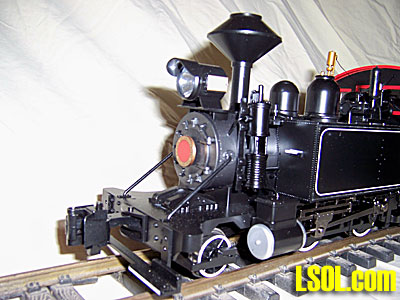 On the left side of the engine mounted to the smoke box is a highly detailed compressor. It has full piping to include the steam regulator valve. Steam exhaust is routed into the smoke box. The air output line runs from the compressor to the rear behind the side tank. 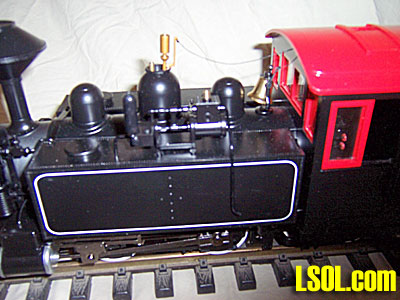
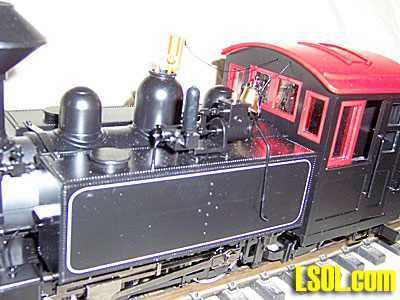
Mounted on top of the left side tank is a transfer pump. Two views are provided. The pump is highly detailed. The steam cylinder has a steam line running from the cab. There is a steam exhaust that runs part way down the side of the tank. The pump has a line that enters the top of the water tank. There is no provision supplied for a water discharge from the pump for either drafting or for water pressure to fight fires, etc. Adding a discharge line would be an easy addition.
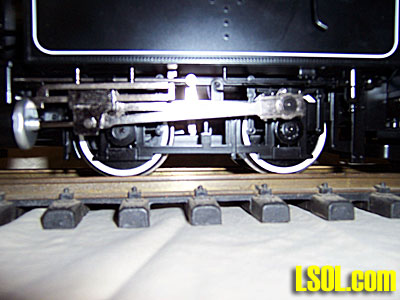 This is a look at the drivers, rods, steam chest with lubricator line. The engine is equipped with Stephenson valve gear.. The steam chest has a working metal valve stem driven by a metal rocker arm. The arm is attached to eccentrics mounted on the front drive axle. Crosshead and crosshead guide is metal. Note that the engine is outside frame with driver counter weights mounted on the drivers. All parts are metal with the exception of the outside frames that are plastic. These outside frames are more substantial and highly detailed when compared to the 1994 version of the locomotive. Note the water injector line with regulator is running from the bottom of the tank to the cab. There is an injector line on each tank. 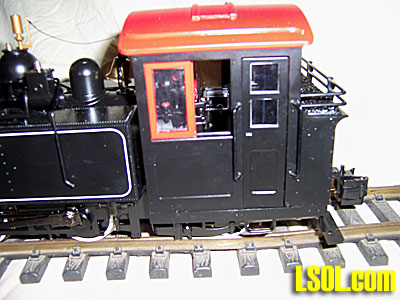
The engine has an all weather cab with working doors. The doors may be placed in the closed position, or since they are spring loaded the doors may be opened. The rear cab side windows slide forward.
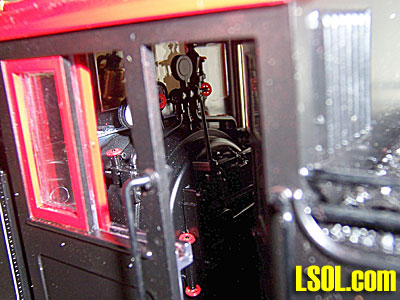 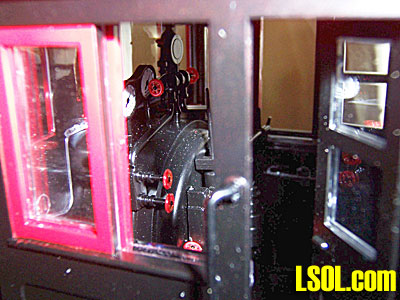
These are somewhat limited views of the cab interior and backhead details. The detail matches that found on the Anniversary 10-Wheeler Big Haulers. A little difficult to see with the all weather cab but the detail is there. The locomotive comes with a factory installed and wired speaker. The speaker is mounted in the coal bunker. The speaker grill is the back wall of the cab. Wires from the speaker are plugged in to the main circuit board. To gain access to the speaker four screws are removed from the bottom of the cab floor. With the screws removed the cab may be lifted off to gain access.
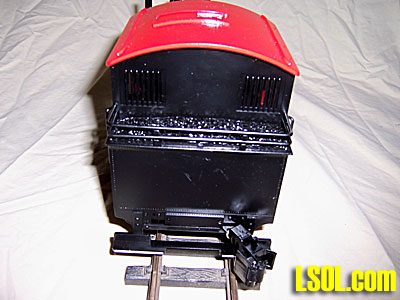 A view of the back of the locomotive. There are vertical bars over the rear windows. They keep coal from breaking the back cab glass. Of note in this picture is the rear coupler swing. I put the coupler at its extreme swing to show it has a full range of motion from one side of the engine to the other. There should be no problem pulling cars off the track even on 2 foot radius curves. For those who desire a coupler that sets closer to the rear of the engine there is a shorter shank coupler that can replace the coupler attached on the locomotive as delivered. 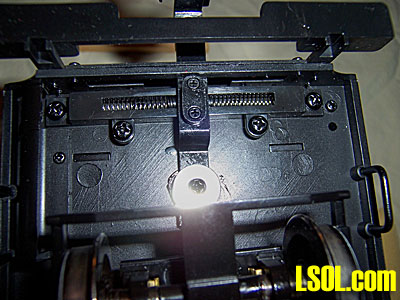
This picture shows the centering springs for the rear coupler. You can see that this arrangement is what allows the coupler to have such a wide arc. This arrangement has been used by Bachmann on its 2-6-6-2T and the Forney. It's a great setup that helps keep cars from being pulled off the track.
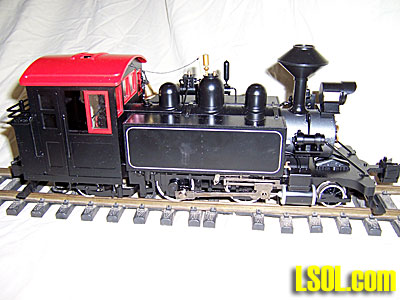 The right side of the engine is almost an exact match to the left side. There is no transfer pump and this side of the locomotive has a turbo generator mounted. 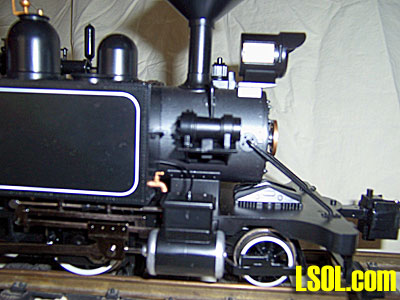
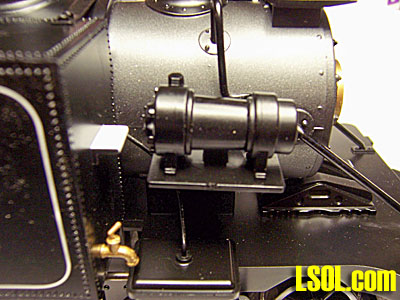
Two views of the turbo generator mounted to the smoke box just in front of the right side water tank. The generator has good detail. There is a steam exhaust line that goes to the smoke box. However the turbo is lacking a steam line to run the turbo and there are no electric lines attached to the generator end of the unit. Still the generator gives a good appearance. Adding a steam line and electric output line would be an easy task. One parting note before we take a look inside. The locomotive has all wheel electrical pickup. So, there are eight wheels picking up track power. On the first protracted run of this locomotive electrical pickup was good and the engine operated through its full speed range with no hesitation.
THE LOOK INSIDE:First step will be to turn the locomotive over. An engine service stand will make working on the underside of the engine easier and protect the top side from damage. If no engine stand then cut a couple of pieces of soft foam to support the engine. 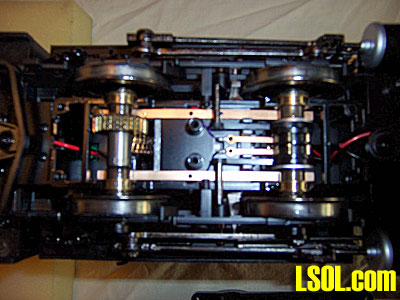
The motor block cover is held in place with six screws. When removing these screws note that the back two screws are longer than those in the middle and front. These longer screws have to go back in their rear position in order to properly secure the cover. Note that the gear case is exposed. The gears are metal. If the bottom cover is removed then take the opportunity to add a little gear lube to the gear case. As received the gear case was well lubricated. Any good gear lube will work. I prefer Super Lube manufactured by Synco of Bohemia, NY. For oil on any part of a locomotive I use Bachmann EZ Lube Light Gear Oil. The motor block case is plastic. Note there are brass bushings, with shoulders, that set in the case to support the axles. When replacing the bottom cover make certain these brass bushings have stayed in place to properly support the drive axles.
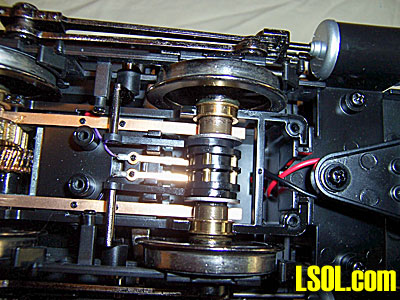 This is the front axle. Note the sound drum in the middle of the axle. It has four contacts so the engine will give four chuffs per driver revolution. You can also see the brass contacts that rub on the sound drum. They are attached with wires to the main circuit board. 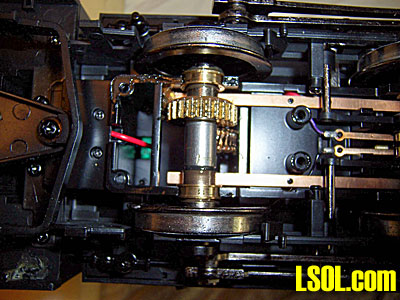
There are two white arrows that point to the axle eccentrics that are the heart of the Stephenson valve gear system. These eccentrics are what drive the rocker arms and valve stems mentioned earlier. While the cover is removed it would be a good time to lubricate these eccentrics. When this engine was opened up the axles at the brass bushings and the eccentrics were well lubricated. No need to lubricate inside the motor block before placing the 2-4-2T in service.
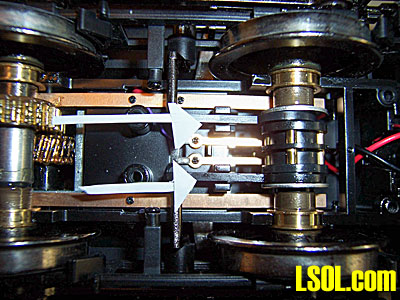 This is the rear axle and gear case. As mentioned note that the gears are metal. The gear train was well lubricated when the engine was opened up. Of note. The metal axle drive gear has two key ways cut 180 degrees apart on the inside diameter of the gear. There are two machined raised portions on the drive axle. Not only is the main drive gear an interference fit on the axle, these key ways also lock the gear to the axle. A slipping main drive gear should not be an issue in this drive train. 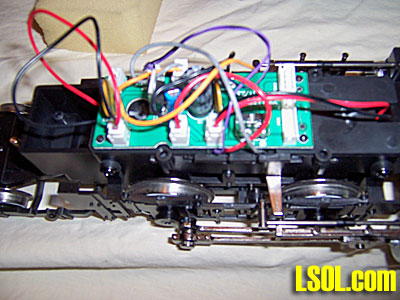
This is the main circuit board. To gain access six screws must be removed to lift the boiler and cab from the chassis. Page G911Y-IS002 provides details of the six screws locations. There are four screws at the back of the motor block and two screws in the front just inboard of the cylinders that must be removed. When lifting the boiler and cab from the chassis be careful since there are wires and plugs that attach to the main circuit board. These three plugs must be pulled from the circuit board in order to clear the boiler and cab from the chassis. At the left rear of the circuit board is a two conductor plug that attaches the speaker to the circuit board. The other two plug are the white plugs to the front of the circuit board. The eight pin DCC plug is on the right side of the circuit board just behind the eight wire white plug. As delivered the DCC socket has a dummy plug installed. Refer to sheet G911y-IS005 for a detailed schematic of the circuit board. The supplied reference sheet is titled Connection Diagram.
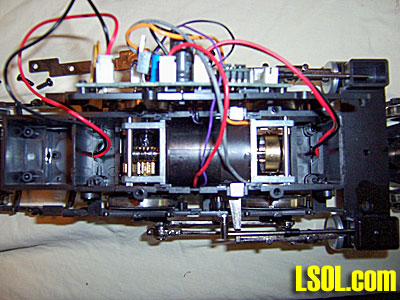 The printed circuit board can be removed to gain access to the motor and top of the gear case. There are four screws that attach the printed circuit board mounting cover that must be removed to gain access. Once at this point the four screws, two on each side are obvious. Remove the screws and carefully move the cover and printed circuit board to one side. Be careful not to pull any wires loose. If necessary to remove the gear case and motor there are two long threaded mounting pins that attach the gear case and motor to the motor block case. Remove these mounting pins and the motor and gear case can be lifted from the engine. This Completes The Inside Look At The 2-4-2T Since Bachmann did not supply an Owner's Manual or any lubrication information here are a couple of pictures that point out lubrication points on the locomotive. They are not the best pictures and I need to take a class in making arrows! 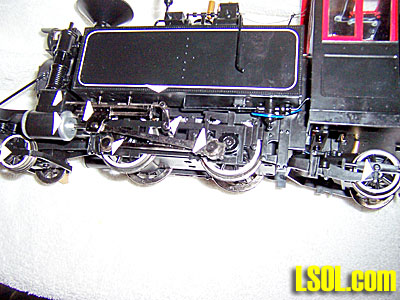
These two pictures depict where the locomotive should be lubricated when required. As mentioned previously I use Bachmann EZ Lube light gear oil for all lubrication except drive gears. The white arrow points indicate lubrication points on the locomotive. Note. In the first picture there are white arrow points on the front and rear trucks. In fact the truck axles are lubricated when the engine is turned over. Just one side of the locomotive is shown. Lubrication on the other side would be at exactly the same points.
OBSERVATIONS:At 4 lbs 2 oz the little 2-4-2T will not be a stump puller. I've had it handle a track cleaning car and three Bachmann extended length J&S coaches on level track without wheel slip. It will pull three Bachmann 1:20.3 freight cars without wheel slip. Add a fourth car and there is wheel slip. If you plan to run on any grades with just a few cars then weight will no doubt have to be added. There are plenty of places to add weight inside the boiler and even a few places in the chassis.. With its robust gear train additional weight should not damage the gear train. I think an additional pound or so of weight would make all the difference in the world when it comes to the engine handling grades with a modest load. There is ample room inside the boiler for just about any manufacturers sound card. The supplied speaker and attachment points on the printed circuit board should make sound installation rather easy. While the level of detail is not that of a Spectrum model there should be sufficient detail to satisfy most owners. The detail and construction is way beyond the original 1994 model 2-4-2T. I would recommend that the crank pin bolts and the Phillips head screws that attach the drivers be checked for tightness. On the model reviewed all of the bolts and screws were tight and did not loosen up after about 10 hours of running. Loctite 222 would be added insurance on the crank pin bolts and Phillips head screws. Sure would have been nice to receive an Owner's Manual and lubrication guide with this engine. If you are running a railroad with tight curves or want a small engine for light switching duties this could be the engine for you. I will say I was surprised at the level of detail on this little engine. For around a street price of 200.00 or so dollars the locomotive seems to be good value. 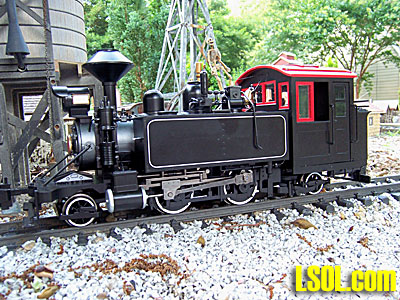
| GREAT DETAILED REVIEW |
| Thank you for the great review.The photos are excellent. ROMMEL |
| MIKE GRUBER - 06/22/2011 - 12:23 |
| The English version of this loco. |
| Where can I find what the English version of this locomotive looked like? |
| Stephen Auslender - 06/24/2011 - 14:59 |
| English Version Lyn |
| http://www.bachmanntrains.com/home-usa/products/images/uploads/91196a.jpg This is the link to the Bachmann site that shows the 2-4-2T Lyn |
| JD Miller - 06/24/2011 - 16:19 |
| Another Lyn Picture |
| http://img269.imageshack.us/img269/1616/img0560y.jpg This picture is also posted on the Bachmann site. Not a real clear picture but it's the best I could find. |
| JD Miller - 06/24/2011 - 16:24 |
| 2-4-2 review |
| Thank you . An excellent & informative review. On this basis I will look out for this Engine as I have just sold the earlier version. Very useful. |
| john blakeley - 06/25/2011 - 03:03 |
| Big Improvement |
| Jon Enjoyed the article,seems to me it is a large improvement from the 1st generation Lyn.The Lyn could make a nice starter set for someone wanting to get into large scale or as you mentioned some one that has tight radius on there pike. Surprised to see metal gears,is there any gear noise at all?The level of detail I must say is also a big improvement. Thanks for the article. |
| Bob Gentile - 06/25/2011 - 05:02 |
| gear Noise |
| Bob, With the metal gears there is a very slight gear whine. Nothing objectionable that would cause me not to purchase this locomotive. I've heard a lot louder gear noise from any number of locomotives, both steam and diesel outline, that have a combination of metal and nylon/delrin gear trains. |
| JD Miller - 06/27/2011 - 05:48 |
| Bachamnn Baldwin 2-4-2T |
| Thanks for this review and the detailed photos . I just purchased one myself , and I am impressed with its detail and quality a LOT ! Its come a long way since those first Big Haulers , a long way in quality . I am really pleased with the looks and the running qualitys . |
| Dennis Paulson - 08/24/2012 - 17:41 |
Top of Page
|



